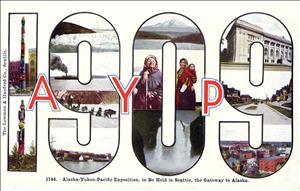On October 13, 1909, University of Washington students unleash their youthful energy on celebrating their Special Day at the Alaska-Yukon-Pacific (A-Y-P) Exposition. The exposition took place on the University of Washington campus in Seattle between June 1 and October 16, 1909. More than three million visitors came from around the state, the nation, and the world to view hundreds of exhibits, stroll the lushly manicured grounds, and be entertained on the midway, while Seattle promoted itself as a gateway to the rich resources of Alaska, the Yukon, and Asia. Each day (except Sundays) of the A-Y-P was designated as a Special Day for one or more groups. Special Days drew people involved in the featured organizations, and the resulting programs, lectures, ceremonies, parades, and athletic competitions gave local people a reason to visit again and again. Students organized a callithumpian parade, a Grand Ball, a push-ball contest, a vaudeville show, and a "nightshirt parade" on the Pay Streak. The students raised such a ruckus that the A-Y-P officials called on Seattle citizens to attend the fair in great numbers on the last day of the fair, October 16th, so that they could end the exposition on a more respectable note.
The morning started with a parade around the grounds. The students had made signs for many Eastern colleges, with the idea that alumni of those schools would fall in behind the signs in the parade. About 1,500 current and past students from the University of Washington joined the parade, along with a large number of other schools' alumni.
A Boisterous Parade
The parade led to the Auditorium, where J. E. Chilberg (1867-1954), representing the Alaska-Yukon-Pacific Exposition Company, presented the permanent buildings from the fair to the University, represented by President Thomas F. Kane (1863-1938). The vice president of the Association Students, Will Prater, accepted the buildings on behalf of the students. Professor Edmond S. Meany (1862-1935) gave a speech about the university's history.
In the afternoon a boisterous parade snaked its way through the exposition grounds. Floats, juniors and seniors in cars with freshmen and sophomores behind on foot, and all sorts of random entries in between, such as, "an army corps styling itself the 'University Cadet Company,' clad in odds and ends of the uniforms and regalia supposed to be worn by soldiers with popguns, tin swords, gold braid and plumped hats" filled the parade ("Students Take Part in Exercises at Exposition").
A vaudeville show followed at the Auditorium. College students provided the entertainment, which the crowd filled while their classmates enthusiastically cheered and heckled. The acts ran the gamut from a boxing match to a ventriloquist to musical performances.
Freshmen Win Contest Meant to Show Them Their Place
In the evening one of several battles between sophomores and freshmen, meant to show freshmen their proper, inferior, place on campus, occurred on the exposition grounds. In prior years, groups of freshmen and sophomore men fought hand-to-hand for possession of a cane, in a contest known as the "cane-rush." The student newspaper deemed the cane-rush "barbaric" and the students inaugurated the push-ball contest for Washington Day at the fair. This involved teams from each class trying to push a large ball to the other sides' end of a 110-yard field. The freshmen won.
The day ended with upperclass students attending a formal ball in the Washington State Building. The freshmen and sophomores formed yet another parade, this one around the Pay Streak, in their nightshirts.

